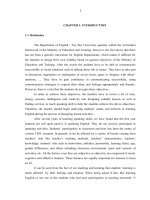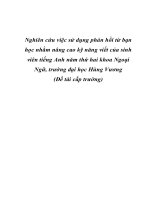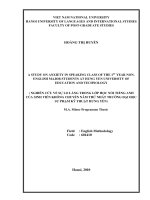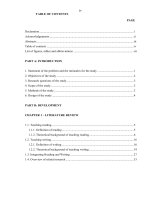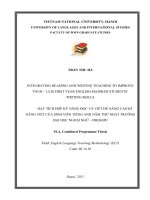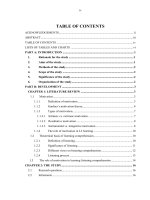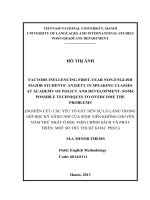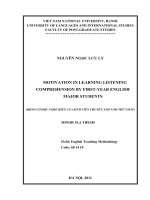Dạy tích hợp kỹ năng đọc và viết để nâng cao kỹ năng viết của sinh viên tiếng Anh năm thứ nhất trường đại học Ngoại ngữ - Đại học Quốc gia Hà Nội đ.PDF
Bạn đang xem bản rút gọn của tài liệu. Xem và tải ngay bản đầy đủ của tài liệu tại đây (1.41 MB, 101 trang )
iv
TABLE OF CONTENTS
PAGE
Declaration i
Acknowledgements ii
Abstracts iii
Table of contents iv
List of figures, tables and abbreviations vii
PART A: INTRODUCTION
1. Statement of the problem and the rationales for the study 1
2. Objectives of the study 2
3. Research questions of the study 3
4. Scope of the study 3
5. Methods of the study 3
6. Design of the study 4
PART B: DEVELOPMENT
CHAPTER 1 – LITERATURE REVIEW
1.1. Teaching reading 5
1.1.1. Definition of reading 5
1.1.2. Theoretical background of teaching reading 6
1.2. Teaching writing 16
1.2.1. Definition of writing 16
1.2.2. Theoretical background of teaching writing 19
1.3. Integrating Reading and Writing 27
1.4. Overview of related research 33
v
CHAPTER 2 – METHODOLOGY
2.1. Rationale for using experimental method 38
2.2. Variables 42
2.3. Participants 43
2.4. Intervention 43
2.5. Data collection instruments 47
2.6. Data collection procedures 50
2.7. Data analysis methods 50
CHAPTER 3 – RESULTS
3.1. Comparison of experimental and control groups’ writing performance 52
3.2. Comparison of writing performance between groups 53
3.3. Survey questionnaire 53
3.3.1. Students’ opinions about the provided course 53
3.3.2. Students’ evaluation of the program 55
3.3.3. Students’ suggestions 58
CHAPTER 4 – DISCUSSION AND IMPLICATIONS
4.1. Discussion of the research questions 60
4.1.1. Comparison of experimental and control groups’ writing proficiency 60
4.1.2. Students’ opinions about the program 61
4.2. Discussion of the research hypotheses 65
4.3. Implications 65
4.3.1. Theoretical implications 65
4.3.2. Pedagogical implications 66
vi
PART C – CONCLUSION
1. Conclusions 70
2. Limitations of the study 70
3. Suggestions for further study 71
REFERENCES 73
APPENDIX 1
APPENDIX 2
APPENDIX 3
APPENDIX 4
APPENDIX 5
vii
LIST OF TABLES, CHARTS, AND ABBREVIATIONS
List of tables and figures
Figure 1
Stages of writing process
Table 1
Schedule of the writing course
Table 2
Descriptive statistics for the pretest and posttest scores of the
experimental and control groups
Table 3
Mean gains of the experimental and control groups
Table 4
Experimental students’ opinions about the reading materials
Table 5
Experimental students’ opinions about the program
Table 6
Experimental students’ suggestions for future program
List of abbreviations
ESL
English as a second language
EFL
English as a foreign language
L2
Second language
TESOL
Teaching English to speakers of other languages
FELTE
Faculty of English Language Teacher Education
ULIS
University of Languages and International Studies
VNU
Vietnam National University
PET
Preliminary English Test
SPSS
Statistical Package for the Social Sciences
1
PART A: INTRODUCTION
This part is dedicated to introducing the rationale of the study, the problem to be addressed
in the study, the aims and the objectives of the study, and the research questions to be
answered. It will also present the scope of the study, an overview of the employed
methods, and the design of the study.
1. Statement of the problem and rationale for the study
English teachers often ask themselves what their students‟ problems are and how they can
help their students. One of the sources which allows teachers to know more about their
students‟ difficulties is students‟ test results. The author has realized that her students‟
performance of achievement tests is very poor, especially students‟ bad performance of
writing tests. The most frequent answer of students when asked about difficulties in writing
is that they cannot express their ideas in English and they find it hard to choose a suitable
word or structure in order to make their writing sound English. One of the most frequently-
made errors relates to the use of unsuitable expressions; moreover, students‟ writing pieces
are affected seriously by their mother tongue. It is clear that students do not have adequate
knowledge of sets of vocabulary, grammatical structure, culture, etc. Thus, they encounter
difficulties in writing and cannot produce creative writing works.
With the purpose of improving the above situation, the author decided to do research on
the topic “Integrating Reading and Writing Teaching to Improve VNUH University of
Languages and International Studies First-year English-majored Students’ Writing Skills”.
Providing supplementary reading materials was believed to bring students the best progress
in a short time because first year students lack background knowledge. Reading passages
and doing supplementary exercises give them a chance to acquire target language and
cultural knowledge, sets of vocabulary and structures as well to help students write better.
However, this method of teaching and learning also has some shortcomings, for example
the preparations, teaching techniques, syllabus, students‟ assessment, etc.
In L2 literacy contexts, Krashen's (1984) argument that “it is reading that gives the writer
the 'feel' for the look and texture” (p.20, cited in Hirvela, 2004) paves the way leading
writing researchers and instructors to the vision of reading/writing connection. He claims
2
that reading, which builds the knowledge base of written texts, helps L2 learners acquire
necessary language constructs such as grammatical structures and discourse rules for
writing, and facilitates the process of language acquisition.
The author is always interested in studying writing instructions and has received the
permission and support of the faculty and colleagues; therefore, this study has been
motivated. It is hoped to provide educators and teachers with a clearer insight into how the
theories of integration of reading and writing can influence and correspond to actual
classroom practices.
2. Objectives of the study
Firstly, this study is carried out to investigate the theories and findings of the earlier studies
and provide more empirical evidence for the effects of integration of reading and writing
on learners‟ writing performance to support the tendency of integrated skills teaching in
the context of Vietnam and the author‟s workplace. Secondly, it is an attempt to meet the
needs of the first year students in University of Foreign Languages and International
Studies (ULIS) to improve their writing ability. Thirdly, it is expected that the results of
the study would be useful in some ways for teachers and educators in university who are
teaching reading and writing at the same time or anyone who is interested in this field of
the English language teaching. Finally, the study is aimed at providing more information
for the trend of integrating skills to teach English language learners in the division.
This study specially has the following objectives:
1. Investigating the effects of the integrated reading and writing instruction program
on first year students‟ writing performance in EFL settings.
2. Investigating the students‟ opinions about the integrated reading and writing
instruction program.
3. Offering some practical recommendations for improvement of first year students‟
writing skills at English I.
3. Research questions of the study
3
In order to achieve the above-mentioned objectives, the research questions of the study are
set out as follows:
(1) Is there a difference between the writing performance scores of the control group and
those of the experimental?
(2) What are the students‟ opinions of the integrating reading and writing instruction
program and their suggestions for future research?
The study was conducted to test the following research hypotheses:
H
0
:
There is no difference in writing performance between students who take part in the
integrated reading and writing instruction program and those who do not.
H
1
:
Students who take part in the integrated reading and writing instruction program will
make more progress in writing proficiency test than those who do not participate in such a
program.
4. Scope of the study
This study focuses on the present context at English I, Faculty of English Language
Teacher Education, University of Languages and International Studies, Vietnam National
University, Hanoi (FELTE, ULIS,VNUH). This study investigates the impact of the
program of integrating reading and writing teaching on first year students‟ writing
performance in 15 weeks. These students‟ writing proficiency was measured in correlation
to the application of an experimental reading – writing integration program.
5. Methods of the study
The research method employed in this study is a quasi-experimental design to propose the
research questions and to find out the answers. The method involves the three basic
components of experiments as presented by Selinger and Shohamy, that is, the population
(ULIS first year students), the treatment (the program of integrating reading and writing
4
instruction) and the measurement of the treatment (t-test) (1989, p.136). It is conducted
with the participation of 52 first year students. Data collection instruments include pre and
post tests, and a survey questionnaire. More details can be seen in Chapter 3.
6. Design of the study
This study consists of five chapters. Chapter 1 introduces the research topic, the rationale
for it and provides the aims, the scope, the method, and the research questions as well.
Chapter 2 has an overview of the literature on the field of writing and integration of
reading and writing teaching. Chapter 3 describes the methodology of the study including
information about the respondents, data collection instruments and the procedure of data
collection and analysis. Chapter 4 presents the results of tests and survey questionnaire.
Chapter 5 discusses the findings, draws conclusions, provides pedagogical implications,
discusses the limitations of the study and provides some suggestions for further research.
In this chapter, the author has mentioned the rationale, the scope and the objectives of the
study. The research questions are also presented as well as the employed methods and
design of the study. In the next chapter, she is going to review the relevant literature to
provide a theoretical framework for the study.
PART B: DEVELOPMENT
CHAPTER 1 – LITERATURE REVIEW
5
This chapter provides the theoretical background for the study. It includes theories about
definitions of reading and writing, teaching reading and writing skills, and previous related
research.
1.1. Teaching reading
1.1.1. Definition of reading
There are many definitions of reading, the most frequently quoted of which were proposed
by Foertsch (1998), who has suggested three basic definitions of reading. According to the
first definition, learning to read means learning to pronounce words. In the second
definition, learning to read means learning to identify words and get their meaning. The
third definition is that learning to read means learning to bring meaning to a text in order to
get meaning from it.
Anderson (1985) defines reading as the process of constructing meaning from written
texts. Skilled reading is constructive: learning to reason about written material using
knowledge from everyday life and from disciplined fields of study; fluent: mastery of
basic processes to the point where they are automatic so that attention is freed for the
analysis of meaning; strategic: controlling one‟s reading in relation to one‟s purpose, the
nature of the material and whether one is comprehending; motivated: able to sustain
attention and learning that written material can be interesting and informative; and a
lifelong pursuit: continuous practices, development, and refinement.
Nowadays, the literacy research has brought us a more comprehensive definition of
reading. It recognizes the importance of skill instruction as one piece of the reading
process. It also supports balanced reading instructions for all students (Allington &
Cunningham, 1996). Balanced reading instruction usually means a combination of whole
language and phonics approaches which help students develop awareness of individual
sounds, cueing strategies, and learn to decode the text and comprehend the material (Kelly,
1997). Teachers should pay attention to students‟ learning styles, some students are
"analytic and auditory” ones who benefit from phonics instruction; some students who
have "visual, tactile and global learning styles" profit from a whole language approach
(Carbo, 1996, cited in Stoicheva, 1999).
6
Suleiman (2005) states that reading can be seen as an “interactive” process between a
reader and a text which leads to automaticity or reading fluency. In this process, the reader
interacts dynamically with the text as he/she tries to elicit the meaning and where various
kinds of knowledge are being used: linguistic or systemic knowledge as well as schematic
knowledge. Since reading is a complex process, Grabe argues that “many researchers
attempt to understand and explain the fluent reading process by analyzing the process into a
set of component skills” (1991, cited in Suleiman, 2005) in reading; consequently he
proposed at least six general component skills and knowledge areas: (1) Automatic
recognition skills (2) Vocabulary and structural knowledge (3) Formal discourse structure
knowledge (4) Content/world background knowledge (5) Synthesis and evaluation
skills/strategies (6) Metacognitive knowledge and skills monitoring .
1.1.2. Theoretical background of teaching reading
Reading is an essential part of language instruction at every level because it supports
learning in multiple ways. Rabideau (1993) states the important role of reading activities
for learners to acquire English as a second language: for example, students dictate stories to
the teacher or share orally a common experience. The stories are accessible because they
reflect the language and experience of the learners. These stories and sharing experiences
create reading texts for beginning-level ESL students whose command of vocabulary and
structures in English is limited, as well as for those who are learning to read for the first time.
D'Annunzio (1990) describes a bilingual version of the Language Experience Approach.
Bilingual tutors take whole-class dictations on a class-selected theme, each learner is
encouraged to provide a sentence or two. After the story is completed, it is translated into
English by the tutors, and related reading and writing activities are carried out in English and
the native language. Learners gradually move from these stories to more extended, expressive
writing.
In literature-based programs, learners often select their own reading texts which are of high
interest and low level, fiction or non-fiction books for instance. Books of high level are
sometimes acceptable if cultural concepts and idiomatic expressions are accessible. When
the text is written at an accessible level and the story is engaging, readers usually get past
unfamiliar words and derive meaning from the context. From reading these stories, students
enhance their knowledge and acquire language competence as well such as vocabulary,
7
grammar, cultural customs concepts and idiomatic expressions; therefore, students boost their
language ability.
Rosow (1990) describes using junk mail and other advertisements as reading texts in a
consumer skills class. Whatever they select to read, learners read complete texts that they
have chosen, rather than the short, decontextualized passages commonly found in skills
books.
It is undeniable that reading brings student a lot benefits. The first benefit is that reading
helps to learn the language. Reading material is language input. By giving students a
variety of materials to read, instructors provide multiple opportunities for students to
absorb vocabulary, grammar, sentence structure, and discourse structure as they occur in
authentic contexts. Students thus gain a more complete picture of the ways in which the
elements of the language work together to convey meaning. The second benefit is that
reading provides content information. Students' purpose for reading in their native
language is often to obtain information about a subject they are studying, and this purpose
can be useful in the language learning classroom as well. Therefore, teachers should give
students both authentic reading material and an authentic purpose for reading. The last
benefit is that reading gives learners cultural knowledge and awareness. Reading everyday
materials that are designed for native speakers can give students insight into the lifestyles
and views of the people whose language they are studying. When students have access to
newspapers, magazines, and internet, they are exposed to culture in all its variety, and
monolithic cultural stereotypes begin to break down.
The Little Red Reading Book (Illinois State Board of Education, 1997) lists essential
components of research-based programs for beginning reading instruction in which it
stated that learners will have opportunities to:
- Expand their use and appreciation of oral language.
- Expand their use and appreciation of printed language
- Hear good stories and information books read aloud daily.
- Understand and manipulate the building blocks of spoken language
- Learn about and manipulate the building blocks of written language.
8
- Learn the relationship between the sounds of spoken language and the letters of written
language.
- Learn decoding strategies.
- Write and relate their writing to spelling and reading.
- Practice accurate and fluent reading in decodable stories.
- Develop new vocabulary through wide reading and direct vocabulary instruction.
- Read and comprehend a wide assortment of books and other texts.
- Learn and apply comprehension strategies as they reflect upon and think critically about
what they have read.
With respect to types of reading, there are two types of reading, extensive and intensive
reading (Hedge, 2003, cited in Suleiman, 2005). Extensive reading refers to skimming and
scanning activities or quantity of material. Hafiz and Tudor (1989) state that:
the pedagogical value attributed to extensive reading is based on the assumption that
exposing learners to large quantities of meaningful and interesting L2 material will, in
the long run, produce a beneficial effect on the learners‟ command of the L2. (p. 5)
Hedge (2003) states that since extensive reading helps in developing reading ability, it
should be built into an EFL/ESL programme which provides the authentic texts, i.e. “not
written for language learners and published in the original language” (p. 218) - and
“graded”. Moreover, extensive reading enables learners to achieve their independency by
reading either in class or at home, through sustained silent reading (SSR). Carrell and
Eisterhold (1983) argue that SSR activity can be effective in helping learners become self-
directed agents and an SSR program is “based on student-selected texts so that the students
will be
interested in what they are reading. Students select their own reading texts with
respect to content, level of difficulty, and length.” (p. 567)
Hedge (2003) states that
extensive reading helps greatly in
“exposing” second language
learners to English and especially when the class time is limited. Hedge briefs the advantages
of extensive reading in the following lines:
Learners can build their language competence, progress in their reading ability, become
more independent in their studies, acquire cultural knowledge, and develop confidence
and motivation to carry on learning. (p. 204-205)
9
In intensive reading, students usually read a page to explore the meaning
and to be
acquainted with writing mechanisms. Hedge argues that it is “only through more
extensive reading that learners can gain substantial practice in operating these strategies
more independently on a range of materials.” (p. 202). These strategies can be either text-
related or learner-related: the former includes an awareness of text organization, while the
latter includes strategies like linguistic, schematic, and metacognitive strategies. Moreover,
Hafiz and Tudor (1989) differentiate extensive and intensive reading:
In intensive reading activities learners are in the main exposed to relatively short texts
which are used either to exemplify specific aspects of the lexical, syntactic or
discoursal system of the L2, or to provide the basis for targeted reading strategy
practice; the goal of extensive reading, on the other hand, is to „flood‟ learners with
large quantities of L2 input with few or possibly no specific tasks to perform on this
material. (p. 5)
Day and Bamford (2002) have offered ten principles for an extensive reading to teaching
foreign language reading as follows:
(1) The reading material is easy
To help beginning readers feel comfortable and confident in reading and get the overall
understanding of the text, there should not be too many new words which make students
nervous and confused. He suggested that for intermediate learners, no more than five difficult
words per page, should be used. Hu and Nation (2000) suggest that learners must know at
least 98% of the words in a fiction text for unassisted understanding.
It also mentions that for advanced learners the text should be adapted to help students with the
linguistic and knowledge constraints of language learners. This is especially helpful when
learners read independently, without the help of a teacher.
Moreover, easy materials help students to be motivated to read more and study more, and to be
able to ladder up as their foreign language and reading skills improve, they must be
reading texts that reflect their language ability. The suitable texts help students find easy and
enjoyable at every step of reading.
10
(2) A variety of reading material on a wide range of topics must be available
The success of extensive reading depends largely on enticing students to read. If the reading
materials are various and exciting, they will awake and encourage students to read and they
also support different purposes of reading. Therefore, various and available sources should be
facilitated such as books, magazines, newspapers, fiction, non-fiction, texts that inform, texts
that entertain, and so on.
As a result, learners are provided with interesting materials, they will be likely to read for
different reasons (e.g., entertainment; information; passing the time) and in different ways
(e.g., skimming; scanning; more careful reading).
(3) Learners choose what they want to read
Learners may choose what they expect to understand, to enjoy and to learn from. They are not
made to read anything that they find to be too difficult or of interest which discourage them to
read more. Further, this technique is really important and helpful when students are assigned
homework which students are learning on their own. As Henry (1995) observes, "compliance
means reading books, but other than that, the purposes and pleasures to which students put
their reading are entirely their own" (p. 69). This encourages students to become responsible
for their own learning. Samuels, (1991) in discussing first language reading, claims that
"unless we phase out the teacher and phase in the learner, many of our students will fail to
become independent because throughout their education they were always placed in a
dependent role - dependent on the teacher".
(4) Learners read as much as possible
This principle is made by the previous one. When students are interested in reading, they can
read what they like, they can read more. The most critical element in learning to read is the
amount of time spent actually reading because students do not always have incentive or aim to
read. Hence, it is very important for students to establish a reading habit, especially for low-
level students, they should have a realistic target to make progress in learning.
(5) The purpose of reading is usually related to pleasure, information and general understanding
In an extensive reading approach, learners are encouraged to read for the same kinds of reasons
11
and in the same ways as the general population of first-language readers. This sets extensive
reading apart from usual classroom practice on the one hand, and reading for academic
purposes on the other.
A reader's interaction with a text derives from the purpose for reading. In extensive reading,
the learner's goal is sufficient understanding to fulfill a particular reading purpose, for example,
the obtaining of information, the enjoyment of a story, or the passing of time.
(6) Reading is its own reward
The learners' experience of reading the text is at the center of the extensive reading experience,
just as it is in reading in everyday life. Therefore, extensive reading is not usually followed
by comprehension questions. It is an experience complete in itself.
Teachers may ask students to complete follow-up activities based on their reading. From that
teachers can find out what the student understood and experienced from the reading; to
monitor students' attitudes toward reading; to keep track of what and how much students read;
to make reading a shared experience; to link reading to other aspects of the curriculum.
Students may be asked to do such things as write about their favorite characters, write about
the best or worst book they have read, or do a dramatic reading of an exciting part of a novel.
Such activities help students to integrate what they read with their own experiences to produce
interesting writings.
(7) Reading speed is usually faster rather than slower
When learners are reading a material that is suitable for their linguistic ability, for personal
interest, and for general rather than academic purposes, they will have an incentive to read
faster and improve their reading fluency. Nuttall notes that "speed, enjoyment and
comprehension are closely linked with one another" (1996, p.128). She describes "The
vicious circle of the weak reader: reads slowly; doesn't enjoy reading; doesn't read much;
doesn't understand; . . ." (p.127). Extensive reading can help readers "enter instead the cycle
of growth. . . . The virtuous circle of the good reader: reads faster; reads more; understands
better; enjoys reading; reads faster. . ." (p. 127).
To promote students‟ reading fluency, it is advisable for teachers to discourage students from
12
using dictionaries when they come across words they don't understand. Extensive reading is a
chance to keep reading, and thus to practice such strategies as guessing at or ignoring
unknown words or passages, going for the general meaning, and being comfortable with a
certain level of ambiguity.
(8) Reading is individual and silent.
Silent, individual extensive reading contrasts with the way classroom texts are used for
teaching language or reading strategies or (in traditional approaches) translated or read aloud.
It allows students to discover that reading is a personal interaction with the text, and an
experience that they have responsibility for. Thus, with freedom to choose reading materials,
individual silent reading can help students discover on their own how foreign language reading
fits into their lives.
Extensive reading means learners read at their own pace. It can be done both in the students'
own time when and where the student chooses, or inside the classroom when part or all of a
classroom period is set aside for silent, self-selected reading as Henry describes it, "the most
beautiful silence on earth, that of students engrossed in their reading" (1995).
(9) Teachers orient and guide their students.
There are many available sources; students may have difficulty choosing the right materials.
For this reason, teacher must guide and provide students with necessary instructions and help.
Teachers can explain that reading extensively leads not only to gains in reading proficiency but
also to overall gains in language learning. Teachers can reassure students that a understanding
of what they read is appropriate for most reading purposes. It can be emphasized that there
will be no test after reading. Instead, teachers are interested in the student's own personal
experience of what was read for example, was it enjoyable or interesting, and why.
Moreover, students should be introduced to the library of reading materials and how it is
divided into difficulty levels. It should be remembered that students unaccustomed to browsing
foreign language reading materials may need assistance in selecting appropriate texts of interest
to them.
Teachers can keep track of what and how much each student reads, and their students'
13
reactions to what was read. Based on this information, teachers can encourage students to read
as widely as possible and, as their language ability, reading ability and confidence increase, to
read at progressively higher levels of difficulty.
(10) The teacher is a role model of a reader.
Nuttall famously said, "Reading is caught, not taught" (1996, p.229). Maley explains the
implications of this for teachers when he says, "We need to realize how much influence we
have on our students. Students do not just learn the subject matter we teach them; they learn
from their teachers. Teacher attitude, more than technical expertise, is what they will recall
when they leave us" (1999). In short, effective extensive reading teachers are themselves
readers, teaching by example the attitudes and behaviors of a reader. In Henry's words,
teachers are "selling reading" (1995: 52), and the primary way to do that is to be a reader.
Further, in Henry's opinion, teachers of extensive reading "have to commit to reading what
their students do" (1995: 52). She explains, "By reading what my students read, I become a
part of the community that forms within the class" (p. 53). When students and teachers share
reading, the foreign language reading classroom can be a place where teachers discuss books
with students, answer their questions and make tailor-made recommendations to individual
students. It can be a place where students and teachers experience together the value and
pleasure to be found in the written word.
Caverly (2009) outlined some principles to develop students‟ reading abilities as follows:
- The reader makes a contribution to the reading process.
- Word recognition is necessary but not sufficient.
- A strong correlation exists between vocabulary development and reading comprehension.
However, developing vocabulary does not necessarily improve reading comprehension.
- Students‟ interest in, motivation for, and attitude toward reading are vital for success.
- Text is organized into super-ordinate, co-ordinate and sub-ordinate ideas.
- Text has a variety of relationships that can be taught to improve comprehension.
- Reading in a study situation is as much a strategic process as it is a comprehending
process.
- Good readers use meta-cognitive strategies to prepare for, monitor, and assess their
progress.
14
- Strategic reading must vary depending on the task demands.
In terms of reading activities used in the classroom, Suleiman states that contemporary
reading tasks involve three-phase procedures: pre-, while-, and post- reading stages.
Zhang believes that “comprehension is facilitated by explicitly introducing schemata
through pre-reading activities” (1993, p.5). The pre-reading stage helps students have
relevant schema or background knowledge which motivate students before the actual
reading takes place. Moreover, pre-reading brings students interest and attention to reading
text.
Drucker (2003) suggests the following procedure teachers can take before reading
a text:
…relate the passage students are going to read to something that is familiar to them.
Next, provide a brief discussion question that will engage the students and, after that,
provide an overview of the section they are about to read. Name the selection,
introduce the characters, and describe the plot (up to, but not including, the climax).
Last, direct the students to read the story and look for particular information. (p. 23)
Similarly, Abraham (2002) states that an interactive approach “demands that the teachers
activate the students‟ schema” during the pre-reading phase by helping “students recognize
the
knowledge that they already have about the topic of a text” (p. 6), i.e. through
discussion of
titles, subheadings, photographs, identifying text structure, previewing, etc.
Such activities are called “pre-reading strategies”. As Orasanu (1986) explicates the notion
of “schema” (or background knowledge) which
… can be thought of as a framework containing slots to be filled by incoming
text information. For example, if a reader is presented with a text about going
on vacation, he or she would likely have a slot in the vacation schema for packing a
suitcase. Text statements about folding clothes or carrying bags could then fill the slot.
If a reader did not have a vacation schema with a "suitcase-packing slot," the
information about clothes and bags might not be readily understood. (p. 118)
The aim of while-reading stage (or interactive process) is to develop students‟ ability in
tackling texts by developing their linguistic and schematic knowledge. Hedge (2003) argues
that although some oppose the interactive activities carried during the while-reading phase,
there are only few research studies that show the “effects of intervention and their outcomes”.
15
Moreover, “many students report positively on the usefulness of while-reading activities.”
(ibid, p. 210). On the contrary, Paran (1996) believes that modern interactive reading models
enable SL readers
to be “less reliant on top-down processing” and enable them to achieve
“greater reliance on
bottom-up strategies as they become more proficient” (p. 29). It seems
that teachers can use a balanced approach to teaching reading by incorporating both top-down
and bottom-up processes, provided they are given flexibility in choosing the reading tasks.
Haller (2000, p. 21-24) modeled a number of school-based post-reading activities which
enhance learning comprehension through the use of matching exercises, cloze exercises, cut-
up sentences, and comprehension questions. For the cloze activity, the teacher puts blanks
in the story in place of some of the words, usually every fifth word but not the first or the last
words in the text. A cut-up sentence activity uses sentences from the given text and helps
learners to gain
confidence by manipulating the text in various ways. The use of lines
in matching can be
sometimes confusing for beginners. Haller proposes the use of “paper
strips” at the beginning where a student is given the strips and asked to match for example a
name with its corresponding activity. Later students can work in pairs as they understand the
concept of matching and, finally, the teacher can introduce matching through lines. For extra
practice students can copy their matching word slips onto another sheet of paper.
Researchers have identified and examined some comprehension strategies which are especially
helpful to students. First, activating and using background knowledge states that students should
call up pertinent background knowledge and using that knowledge to help understand what is
being read. Second, generating and asking questions is that they should keep self-questioning
throughout the reading of a text. Third, making inferences is students use background
knowledge or information from the text to evaluate or draw conclusions during reading. The
next strategy is predicting in which they should use background information to make informed
guesses. Moreover, summarizing suggests that students can synthesize information in a text so
as to explain what the text is about. Last, visualizing shows that they may make mental images of
a text as a way to understand processes or
events that are encountered during reading.
1.2. Teaching writing
1.2.1. Definition of writing
16
The psychologist Lenneberg (1967) once noted the similarity between writing and
swimming that human beings learn to walk and to talk but that swimming and writing are
culturally specific, learned behaviors. We learn to swim if there is water available and if
someone teaches us, we learn to write if we are members of a literate society and if
someone teaches us. There are non swimmers, poor swimmers, and excellent swimmers, so
it is for writers. So how to teach second language learners of English how to write well is
still the concern of many educators and researchers. Writing is of fundamental importance
to learning, to development of the person in each learner, and to success in the educational
system. As teachers, we need to work continually to aid our students in their search for
fulfillment as writers (Graham & Harris, 1993).
Lannon (1989) views writing as “the process of transforming the material discovered by
research inspiration, accident, trial or error, or whatever into a message with a definite
meaning- writing is a process of deliberate decision” (p.9). It means that writing must
convey a message with a meaning.
The writing has been defined in a number of ways which reflects the complexity of writing
process. According to Byrne, writing can be seen as an “act of forming graphic symbols”,
that is, letters or combination of letters (Byrne, 1991, p.1). Simply, writing is like “making
marks on the flat surface of some kinds”.
Another definition offered by Tribble (1996), considers writing a language skill involving
“not just a graphic representation of speech, but the development and presentation of
thoughts in a structured way” (p.3)
Besides, according to Sokolik, writing is defined by several contrasts (cited in Nunan,
2003). Firstly, in her opinion, writing is both “a physical and a mental act” in the sense that
it requires writers to commit words or ideas to some medium and at the same time to
invent ideas, think about how to express them, and organize them into statements and
paragraphs. Secondly, writing aims at expressing and impressing. Writers typically try to
express their ideas or feelings; meanwhile they need to impress their readers in certain
ways. Thirdly, writing is a process and a product. Writers have to generate ideas, organize,
draft, edit, reread to produce a product – a paragraph, an essay or a report.
17
Grabe and Kaplan (1996), explore the meaning of writing in terms of the rhetorical triangle
in writing. And such triangle consists of the reader, the recipient of the final product of the
writing process; the writer, the originator of the message; and the subject matter and text
itself. Both the writer and the reader have to consider all these aspects when writing and
reading, respectively, for each one plays a significant role in the journey towards meaning.
Fischer (2003) argues that no one definition of writing can cover all the writing systems
that exist and have ever existed. Instead he states that a 'complete writing' system should
fulfill all the following criteria:
it must have as its purpose communication;
it must consist of artificial graphic marks on a durable or electronic surface;
it must use marks that relate conventionally to articulate speech (the systematic
arrangement of significant vocal sounds) or electronic programming in such a way that
communication is achieved.
In her article, Boughey (1997) gives some characteristics of capacity of writing as follows:
(1) Writing is a process of “exploring one‟s thoughts and learning from the act of writing
itself what these thoughts are” (Zamel, 1982). This process also succeeds in giving
thoughts a permanence which they would not have in their unwritten state. By
externalizing and giving permanence to thoughts, the act of writing allows writers to
reconsider, clarify, and revise those thoughts more readily than if they had not been written
down.
(2) All texts are written for an audience even if that audience is the writer himself or
herself. The need to pay attention to the audience of the text prompts writers into
anticipating and considering viewpoints other than their own. The result of this is that
propositions contained in the content of the text are likely to be more rigorously scrutinized
than if they were simply thought about.
(3) In contrast to speaking, writing is produced and received in a context which is devoid
of support for the communication of meaning (Cummins, 1986). The result of this is that,
in writing, meanings must be explicit. Understanding of the need to be explicit forces
writers to engage with the propositions contained in their text more than in speaking.
18
(4) In speaking, meaning is constructed through a process of interaction which involves
both the speaker and the listener. Speakers and listeners prompt each other by providing or
questioning links between propositions. They help each other to construct a meaning which
may not be completely shared. In contrast to speaking, writing is a lonely process requiring
writers to explore, oppose and make connections between propositions for themselves, a
process which is conducive to learning.
(5) The linear form of a finished piece of writing requires that thoughts be ordered and
organized. The process of organizing and ordering these thoughts means that the writer has
to examine and manipulate those thoughts thoroughly.
These characteristics show the relationship between writing and learning, therefore,
students should learn to write. Learning to write can help students improve their language
ability and enhance their other language skills.
1.2.2. Theoretical background of teaching writing
People often communicate with each other in writing. For example writers transfer their
thoughts, ideas, and feelings to readers or people write letters to each other to keep in
touch. However, communication is not the only reason to include writing as a part of
second language syllabus. There is another important reason is that writing helps students
to learn. Through writing students can reinforce their grammatical structures and
vocabulary. Moreover, they can experience the target language and become involved in the
new language. Additionally, writing provokes students, it makes students think, create and
discover new things while trying to express their ideas. For these above reasons, writing is
really important to teach in ESL lessons. There are many studies carried out to explore the
nature and techniques of teaching writing to students in ESL classes.
Marc Freedman (1991) has done a small survey of current uses of writing in adult ESL
classes. He found three purposes for writing. The first purpose has to do with practicing
language: "Many traditional, workbook-style writing exercises seem predicated on the idea
that practicing writing correctly formulated serves the purpose of concretizing learning "
(p.11).
19
The second purpose has to do with experimenting with language, encouraging learners to
attempt to write things they want to express, even if they are unsure of how to do it. This
emphasis does the following:
* It develops an experimental or exploratory approach to language and literacy learning in
which the learner plays an active role;
* It allows learners to set their own goals and focus on the language necessary for what
they are trying to convey in writing;
* It provides opportunities for learners to explore resources other than the teacher (e.g.,
their own, perhaps underestimated, knowledge; the knowledge of other students;
dictionaries; texts; or their own notes) (p. 12).
The third purpose has to do with "communication." While an oral utterance is usually
based on a preceding utterance or event, has an immediate impact on what happens next,
and is of immediate concern to the speaker, many writing activities share none of these
characteristics.
To produce a good piece of writing which has clear, fluent and effective communication of
ideas, writers have to pay attention to a number of features such as content, the writer‟s
process (getting ideas, getting started, writing drafts, revising), audience, purpose, word
choice, organisation, machanics (spelling, punctuation), grammar (rules for verbs,
agreement), syntax (sentence structure, stylistic choices)
Raimes (1983) in her book Techniques in Teaching Writing discusses the different
approaches to teaching writing in ESL classes as follows (p.8):
The Controlled-to-Free Approach
The controlled-to-free approach in writing is sequential: students are first given sentence
exercises, then paragraphs to copy or manipulate grammatically by, for instance, changing
questions to statements, present to past, or plural to singular. They work on given material
and perform strictly prescribed operations on it. This approach stresses three features:
grammar, syntax, and mechanics.
20
The Free-Writing Approach
Some researchers emphasized quantity of writing rather than quality. They have
approached the teaching of writing by assigning vast amounts of free writing on given
topics, with only minimal correction of error. The emphasis in this approach is that
students should put content and fluency first and not worry about form.
The Paragraph-Pattern Approach
Instead of accuracy of grammar or fluency of content, the paragraph-pattern approach
stresses another feature, organization. Students copy paragraphs, analyze the form of
model paragraphs and imitate model passages. This approach is based on the principle that
in different cultures people construct and organize their communication with each other in
different ways. Therefore, students need to analyze, practice the particular English feature
of a piece of writing.
The Grammar-Syntax-Organisation Approach
Some teachers have stressed the need to work on simultaneously on several features in the
composition. Writing cannot be seen as composed of separate skills which are learnt one
by one. Students have to pay attention to organization while they work on the necessary
grammar and syntax. This approach links the purpose of a piece of writing to the forms
that needed to convey the message.
The Communicative Approach
The communicative approach stresses the purpose of a piece of writing and the audience
for it. Student writers are encouraged to behave like writers in real life and to ask
themselves the crucial questions about the purpose and audience, for example, Why am I
writing this? Who will read it?
The Process Approach
Other researchers have stressed the process of writing. Writers ask themselves not only
questions about purpose and audience, but also the crucial questions: How do I write this?
How do I get started? In this approach, the students do not write on a given topic in a
21
restricted time and hand in the composition for the teacher to correct. Instead of doing so,
they explore a topic through writing, showing the teacher and each other their drafts, and
using what they write to read over, think about and move them on to new ideas. The
process approach gives students two crucial supports: time for students to brainstorm, try
out ideas and feedback on the content of what they write in their first drafts. Therefore,
writing process becomes a process of discovery for the students, discovery of new ideas
and new language forms to express their ideas.
A few decades ago writing teachers were mostly concerned with the final product of
writing: the essay, the report, the story, and what that product should look like. But in due
course of time, learners were allowed to focus on content and message and their own
individual intrinsic motives were put at the center of learning, the process approach to
writing instruction has been developed. Process approaches do the following (Brown,
1994, p.320):
a) focus on the process of writing that leads to the final written product
b) help student writers to understand their own composing process
c) help them to build repertoires of strategies for prewriting, drafting and rewriting
d) give students time to write and rewrite
e) place central importance on the process of revision
f) let students discover what they want to say as they write
g) give students feedback throughout the composing process
h) encourage feedback both from the instructor and peers
i) include individual conferences between teacher and student during the process of
composition
The process approach is an attempt to take advantage of the nature of written code to give
students a chance to think as they write. Writing is indeed considered a thinking process
like Elbow said (1973) “instead of a two-step transaction of meaning-into-language, think
of writing as an organic, developmental process in which you start writing at the very
beginning-before you know your meaning at all- and encourage your words gradually to
change and evolve”.
